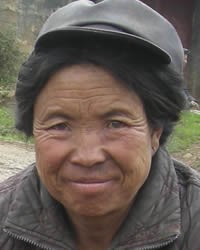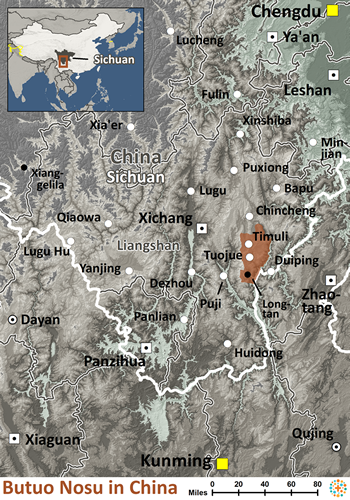The Butuo Nosu originally lived farther north of their present location. Speaking of a neighboring area in northern Yunnan Province, one historian notes, "Between 1796 and 1821, the Chinese extended their influence. At times when the Chinese were weak, the [Nosu] expanded out of Daliangshan: for example, in 1802, 1814, 1838-39, and from 1875 to 1892. By 1907, the Nosu controlled most areas, with the Chinese fortified in the towns. During the troubled times of the early Republic, the number of Chinese troops was reduced in the area, and the Nosu consequently became more troublesome: in 1919, they invaded Zhaojue, in 1920 they burned Xining, and in 1937 they killed the magistrate of Leibo."
The Butuo Nosu are a distinct language group within the larger Nosu ethnicity. The Nosu, in turn, have been officially counted as part of the Yi nationality by Chinese authorities. The Butuo Nosu share very little in common with other Yi groups in Yunnan, Guizhou, and Guangxi, except for some legends and general cultural traits. In many locations the Butuo Nosu live alongside the Suodi.
The Butuo Nosu pride themselves on being tough, resilient, and strong people. Their homes and villages are constructed with high fences, a sign of their violent and murderous past.
The Butuo Nosu practice a complex form of polytheism. They fear and appease numerous mountain deities and spirits of war, harvests, and rivers, among others. They tie these beliefs in with deep reverence for their ancestors.
The Butuo Nosu are a large, unreached people group. There are a few hundred Catholics among them, mostly elderly people who meet in Chinese-language churches. We don't know if the turning to Christ by 12,000 Nosu farther north has impacted the Butuo Nosu. Nosu audio tapes and the JESUS Film are not understood by most Butuo Nosu.
The Butuo Nosu people need to put their hope in the King of kings, realizing that he is the one who gives them worth and dignity.
Pray the indigenous believers will meet in their own churches, not in Chinese-language churches.
Pray for power encounter with local spirits. Pray the JESUS Film will be dubbed into the local language.
Pray for the Lord to intervene in their families, calling people to his side.
Pray for their hearts to be drawn to the Lord of lords.
Pray for a church planting movement to thrive in their communities.
Scripture Prayers for the Nosu, Butuo in China.
Operation China, Asia Harvest, Copyrighted © Used with permission.
| Profile Source: Joshua Project |

























